-
GeneralGeneral
-
Alcohol Counseling Homepage
This Alcohol Counselling introductory course provides a foundation of theoretical and practical knowledge and skills, to deliver counseling treatment to harmful drinkers, build patients' motivation to change their drinking behavior, and provide skills for patients to change their drinking behavior and to prevent and deal with relapses. All parts of this training are free, including registration, learning, testing, and a certificate of completion. The course is intended for laypeople who are providing peer counseling.
This Counselling for Alcohol Problems course is based on the Counselling for Alcohol Problems (CAP) psychological treatment manual, the course was developed in partnership with the PREMIUM program, funded by the Wellcome Trust, in association with the London School of Hygiene & Tropical Medicine, Sangath organization, and the Government of Goa's Directorate of Health Services. Like all NextGenU.org courses, the course is competency-based; this course utilizes competencies adapted from "Counselling for Alcohol Problems (CAP)".
The course developers are Abhijit Nadkarni, Richard Velleman and Vikram Patel; additional contributions were made by Aresh Naik, Akila Kalsur, Ajay Kumar, Urvita Bhatia, Miriam Sequeira and Dielle Dsouza. The authors of the CAP manual are Hamid Dabholkar, Abhijit Nadkarni, Richard Velleman and Vikram Patel.
CAP is a brief psychological treatment, based on Motivational Interviewing, for harmful drinking. The CAP treatment was evaluated in a large randomized controlled trial (RCT) in India, where it was delivered in routine primary health care settings by counselors with no prior mental health experience. The results of the RCT were very positive and you can freely download the scientific publication reporting these results in The Lancet, and review the findings and recognize the large group of international and Indian scientists who have contributed to this effort.
For a publication on this course’s efficacy, see “Counselling for Alcohol Problems (CAP), A Lay Counsellor-Delivered Brief Psychological Treatment for Harmful Drinking in Men, in Primary Care in India: A Randomised Controlled Trial,” (2017), The Lancet, https://doi.org/10.1016/S0140-6736(16)31590-2; see also “Building Public Health Capacity through Online Global Learning,” (2018), Open Praxis, to see more research related to NextGenU.org’s educational model, check out NextGenU.org’s publication page. Subscribe to our newsletter to be notified of future updates, new courses, and to be part of our community.
The main component of this course involves completing the following 10 modules which provide:
- An overview of Harmful Drinking and Alcohol Dependence,
- The phases of Counselling for Alcohol Problems and the objectives of counseling,
- How to empower patients with appropriate cognitive and behavioral skills to change their drinking behaviors,
- Skills to face challenging situations that occur during the counseling process.
At the end of each module, there are self-assessment tests. At the end of the course, you will take a final exam; a chance to evaluate the course will also be provided.
The results of your assessments will be provided to you, and we can report your testing information and share your work with anyone you request (school, employer, etc.). We hope that you will find this a rewarding learning experience, and we count on your assessment and feedback to help us improve this training for future students.
Approximate time for the required readings in this course is 12 hours at an average rate of 144 words/minute; in addition, there are required activities as described above.
At the end of each lesson, there is a practice quiz. At the end of the course, after you’ve completed each lesson, quiz, and activity, you’ll have access to a final exam, and a chance to assess the training. Once you’ve passed that last test, you will be able to download a certificate of completion from NextGenU.org and our course’s co-sponsoring organizations (listed above). We keep all of your personal information confidential, never sell any of your information, and only use anonymized data for research purposes, and we are also happy to report your testing information and share your work with anyone (your school, employer, etc.) at your request. We hope that you will find this a rewarding learning experience, and we count on your assessment and feedback to help us improve this training for future students.
Engaging with this Course:
You may browse this course for free to learn for your personal enrichment; there are no requirements.
To PASS and Obtain a certificate
- Show in the registration fields that you have the appropriate prerequisites to be certified [a high school degree for college courses, a college degree for the master’s level courses, and enrollment in or graduation from a medical doctoral program for our medical doctoral-level courses].
- Complete all the reading requirements.
- Complete all quizzes and pass with a 80% with unlimited attempts.
- Successfully complete the final exam with a minimum of 80% and a maximum of 3 attempts.
- Complete the self and course evaluation forms.
To obtain credit
- Complete all requirements listed above for the certificate.
- Your learning institution or workplace should approve the partner-university-sponsored NextGenU.org course for educational credit, as they would for their learner taking a course anywhere.
-
NextGenU.org is happy to provide your institution with:
- a link to and description of the course training, so they can see all its components, including the cosponsoring universities and other professional organization cosponsors;
- your grade on the final exam;
- your work products (e.g. peer and mentored activities), and any other required or optional shared materials that you produce and authorize to share with them;
- your evaluations -- self, and peer assessments;
- a copy of your certificate of completion, with the co-sponsoring universities and other organizations listed.
To obtain a degree, NextGenU.org co-sponsors degree programs with institutional partners. To obtain a degree co-sponsored with NextGenU.org, registrants must be enrolled in a degree program as a student of a NextGenU.org institutional partner. If you think that your institution might be interested in offering a degree with NextGenU.org contact us.
Next Steps
- Complete the registration form.
- Begin the course with Module 1: Understanding Harmful Drinking & Alcohol Dependence. In each lesson, read the description, complete all required readings and any required activity, and take the corresponding quizzes.
This course meets nationally approved standards of education developed for the addiction/substance use disorders counseling profession. This course's participants are assured that the continuing education (CE) credits provided will be accepted toward national credentialing by the NAADAC Certification Commission for Addiction Professionals (NCC AP), as well as by many of the individual state licensing/certification bodies in the addiction and other helping professions.
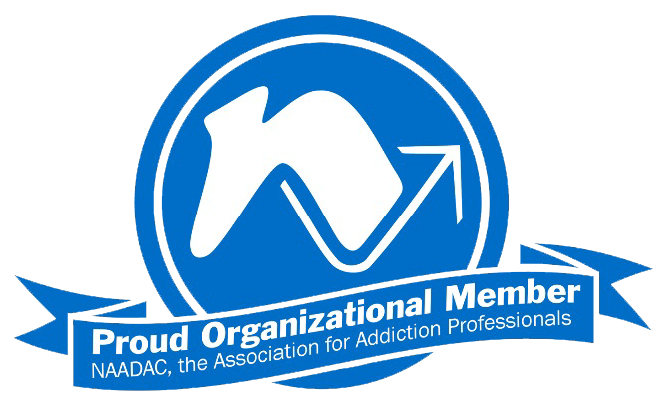
-
Module 1: Understanding Harmful Drinking & Alcohol Dependence
Learning Objectives:
- Warning signs of drinking problems.
- When does drinking become problem drinking, and types of drinking problems.
- Why some people become harmful dependent drinkers.
- Impact of harmful or dependent drinking.
- How to know if someone has harmful or dependent drinking.
- Treatment for harmful and dependent drinking.
-
Module 1: Lesson 1: Warning Signs of Drinking Problems
As counsellors, we meet patients like Raja, Sarah, Joseph and Rashid in the PHC often. This module introduces us to their problems. Often, patients come to the PHC to treat physical problems such as the examples shown above, but as you see, these are caused because they drink alcohol uncontrollably. This is causing them physical, social and financial harm, and can also result in accident-related disease and death.
Common signs of drinking problems:

- Attempted to cut down or stop drinking but failed
- Gets angry if challenged about drinking
- Drinking makes patient feel disgusted, angry or suicidal
- Needs a drink to start the day
- Regularly uses alcohol to feel confident
- Drinks to cope with anger, frustration, anxiety or depression
- Drinking affects relationships with others
- Continues drinking even if it affects work, family and relationships
- Skips days at work or school due to hangovers or takes many sick leaves to recover
- Sometimes drives under the influence of alcohol
- Drinks despite being advised by doctor/counsellor to stop or reduce
- Hides the amount he or she drinks from family and friends
- Drinks to get drunk
- Gets very shaky, sweaty and tense a few hours after the last drink
- Gets ‘memory blanks’ – cannot remember what happened for a period of hours or days after drinking
- Unable to socialise without a drink
- Can drink a lot without getting drunk
- Stops drinking for a short period, but returns to uncontrolled drinking very quickly
The more of these signs a person has, the more likely it is that he/she has a drinking problem. The ones at the top of the list are a sign of greater problems.
-
Module 1: Lesson 2: Drinking Problems & Their Types

When a person drinks in a way that negatively affects him/her or his/her life – including health, work, or relationships – it is considered to be problem drinking. These are the people we need to help with our counselling.
Types of problem drinking
Each of the three types of problem drinking - graded below from least to most severe - is tackled differently.
- Hazardous drinking: When a person drinks in a way that increases his or her risk of developing physical, mental or social harm in the future
- Harmful drinking: When a person drinks in a way that has already started causing some physical (eg liver damage), mental (eg depression) or social harm (eg arguments with friends and family)
- Dependent drinking: Includes a mix of harmful behaviour (eg continued heavy drinking despite clear traces of harmful consequences), harmful thoughts (eg strong desire to drink alcohol), and physical signs (eg withdrawal symptoms such as sweating, uneasiness in the stomach, and in serious cases uncontrollable shaking, vomiting or fits if they do not drink)
The PREMIUM programme has focused on patients with harmful and dependent drinking because:
- There are many men in Goa and India with such problems
- There are effective brief psychological treatments for these drinking problems, which can be delivered by counsellors with appropriate training and supervision
- Although these effective treatments for harmful and dependent drinking exist, there are hardly any facilities for them in developing countries like India
-
Why some People become Harmful or Dependent Drinkers
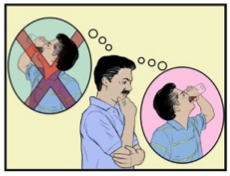
Drinking alcohol is common in some cultures and many drinkers never develop problems. For some however, it becomes troublesome. A few possible reasons for this include:
- Some initially begin drinking to relieve stress or worries, and later depend on the drinking instead of finding constructive ways to deal with problems
- Some slowly increase their drinking and do not realize that they are developing a habit that is difficult to cut down or stop
- Some are so used to drinking heavily on social occasions that they cannot attend a party without drinking
- Some suffer a disturbing situation, such as loss of a close one or job, which sets off problematic drinking
While no single reason applies to all, there is always one – or a set of reasons – that applies to each patient. One of your tasks as a counsellor is to help the patient understand why he/she is drinking heavily and what needs to change so he/she can cut down or stop.
-
Module 1: Lesson 3: Impact of Harmful or Dependent Drinking
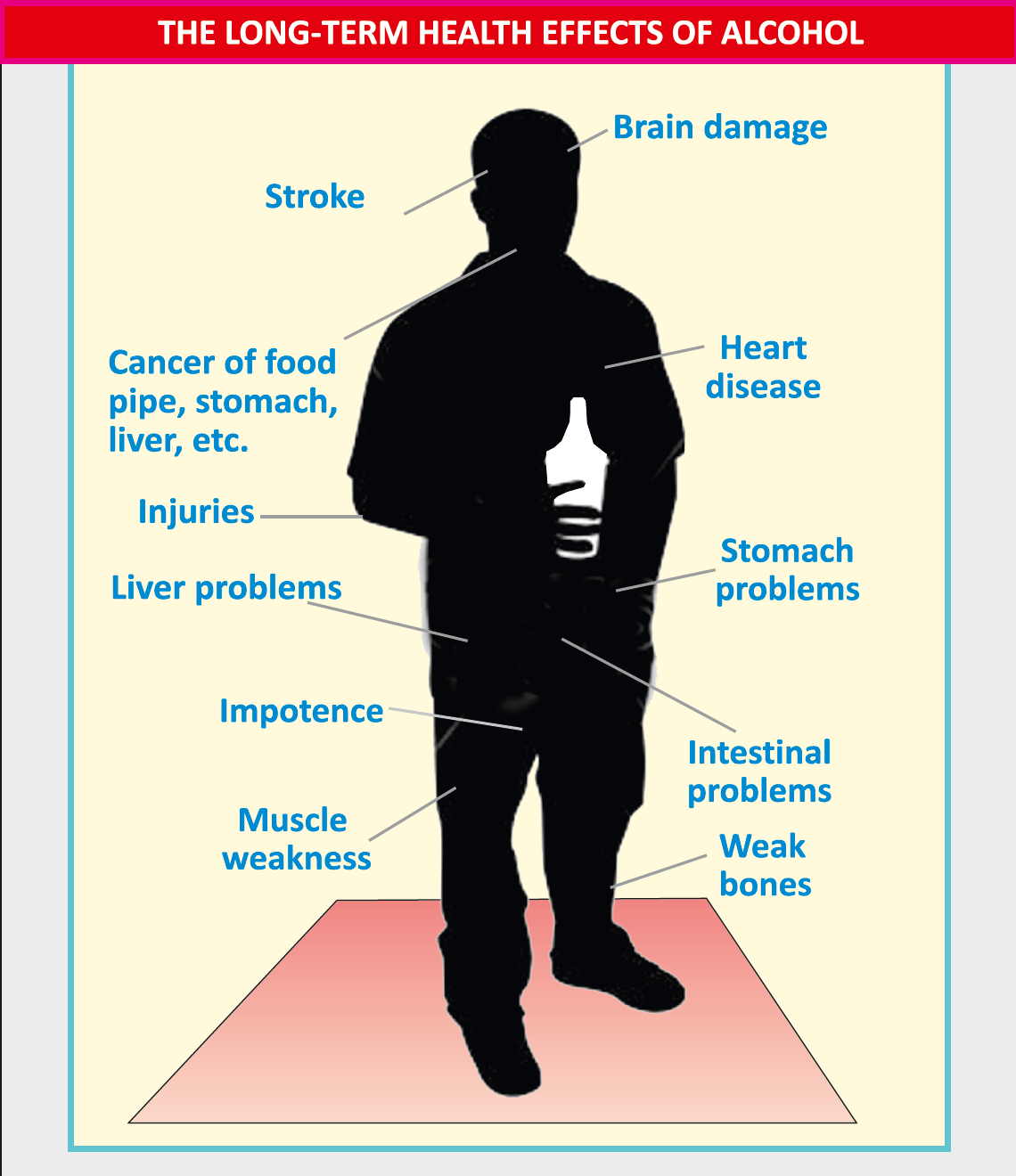
The patient scenarios show how alcohol has affected the patient's lives. The first signs can occur in any area – mental health, family life, physical health, work or social functioning. As the severity of the drinking problem increases, it begins affecting more area.
Harmful or dependent drinking can affect lives in many ways:
- Physical health: The picture shows how alcohol affects nearly every part of the body
- Mental health: Can cause depression (constant sadness and loss of interest with reduced sleep/appetite, feelings of hopelessness, guilt, etc), anxiety (fear or worry without any clear reason), thoughts of suicide, loss of memory, hallucinations (hearing voices or seeing visions even when one is alone)
- Social and family life: Can cause arguments and fights (domestic abuse), debts and other financial problems, failure to look after children, missing family events, legal problems (breaking traffic laws, road traffic accidents)
- Work: Can cause patients to stay away from school or work, repeated job changes, lack of efficiency, fights and arguments, accidents and injuries
- Intoxication: Patients usually drink until drunk, and show deeper signs of drunkenness than normal, such as mood changes, loss of self-consciousness, unclear speech and unsteadiness. This level of drunkenness is linked to violence, damage to property, fights, domestic violence, drunken driving, alcohol-related accidents
- Withdrawal symptoms: A key sign suggesting someone is a dependent drinker. When the patient suddenly reduces or stops drinking, he/she experiences some or all of the following symptoms: disturbed sleep, excessive sweating, racing heartbeat, raised blood pressure, restlessness, headache, weakness, shaking hands, vomiting, hallucinations, and fits. The more the symptoms, the greater the level of dependence.
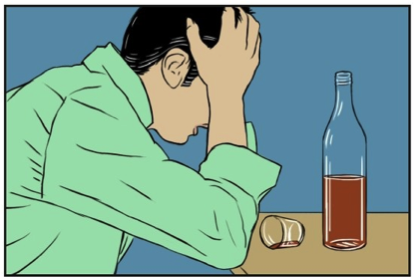

-
Knowing when someone has Harmful or Dependent Drinking
The PREMIUM programme uses the Alcohol Use Disorders Identification Test (AUDIT) to calculate drinking behaviour. It is a set of 10 simple questions with scores from 0 to 40. Patients scoring 12-19 are likely to be harmful drinkers and those scoring 20 or more are likely to be dependent drinkers. AUDIT is usually completed by a health assistant, and only those scoring 12 and above are referred to counsellors.
-
Module 1: Lesson 4: Treatments for Harmful and Dependent Drinking
Counselling – where patients are helped by talking about their problem – is the most useful way to treat harmful and dependent drinkers.
The course will teach you how to deliver CAP to change harmful and dependent drinking behavoiur. It helps patients examine their drinking habit, develop a drive - or motivation - to address the problem, and make changes in their drinking and the reasons why they do so. It shows them how to plan what they want to change and maintain it.
While CAP helps both harmful and dependent drinkers, the latter may need extra help such as medicines for their withdrawal symptoms or in-patient stay. Therefore, we refer dependent drinkers to a specialist consultant psychiatrist, who will work with us to provide this help.
Harmful drinkers do not usually require such treatments, but might have certain alcohol-related health problems like disturbed sleep or reduced appetite which can be helped with medicines. The doctor might also do some blood tests on both types of drinkers to find out how much their body has been damaged by alcohol.
Even in cases when medicines are used, it has been found that results are much better if the patient is also given counselling.
-
Summary
- People drink alcohol for various reasons, but not everyone develops alcohol-related problems
- Problems due to drinking alcohol can be categorised as hazardous, harmful and dependent drinking
- Harmful and dependent drinking can affect various areas of a person’s life, including physical health, mental health, family life, social functioning and work
- The PREMIUM programme targets harmful and dependent drinkers
- The most common and useful way to treat harmful and dependent drinkers is through counselling
- Dependent drinkers are also referred to a consultant psychiatrists to judge whether he/she needs medicines or stay in a clinic/hospital
-
Module 2: Introduction to Counselling for Alcohol Problems (CAP)
Congratulations on completing the Module on Understanding Harmful Drinking and Alcohol Dependence! You now know about the warning signs of drinking problems, the types of drinking problems, their impact, and treatments available.
In Module 2, you will learn
- How people stop or reduce drinking
- What is CAP
- What happens in CAP sessions 1-4
-
Cutting down
If a patient is trying to cut down on drinking, a few things he/she can do are:
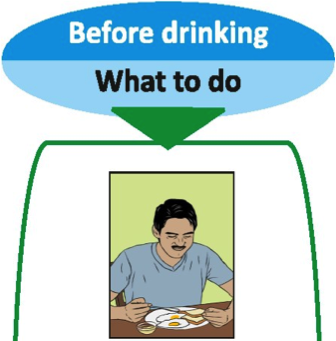
Drink on fewer occasions
- Work out when and why he/she drinks and plan a different activity
- Plan ahead which days each coming week he/she will not have alcohol. There should be at least two alcohol-free days a week
- Avoid social events serving alcohol
Drink less
- Plan how long he/she will be out and how many drinks he/she will have, and stick to the plan
- Introduce drinking rules, such as not drinking before 8pm
- Slow down his/her drinking – ‘sip, don’t gulp’
- Take smaller sips
- Put the glass down in between sips
- Occupy himself/herself with other activities besides drinking, such as playing a game, reading, talking, eating
- Avoid buying rounds of drinks, or when it is the patient’s turn, have a non-alcoholic drink such as aerated beverages, fruit juice or water
- Drink at the same speed as a slower-drinking friend
- At home, avoid finishing the bottle, but leave some for another day
- Practice how to refuse a drink
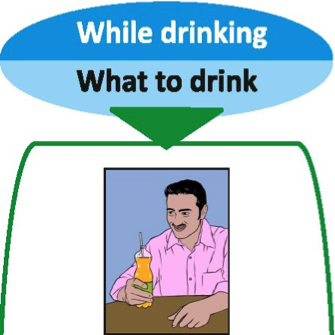
Reduce the amount of alcohol in each drink
- Not all brands of alcohol are the same strength. Switch to a drink with lower alcohol content, eg from rum or the local brew to beer, or from a strong beer to a lower strength one
- Switch to smaller measures – from a large peg (60ml) to a small one (30ml), from a large bottle of beer (650ml) to a small one (330ml), use a smaller glass at home
- Eat before and while drinking since food slows down the body’s ability to absorb alcohol and limits how quickly it gets into the blood. It also lowers chances of developing acidity caused by alcohol
Overall
- Get the patient to involve a family member or friend to support him/her to drink less, control his/her drinking and track progress
- Get the patient to talk through problems and concerns. Stress and worries can influence how much one drinks and talking can be the first step to solving problems with alcohol
-
Stopping drinking
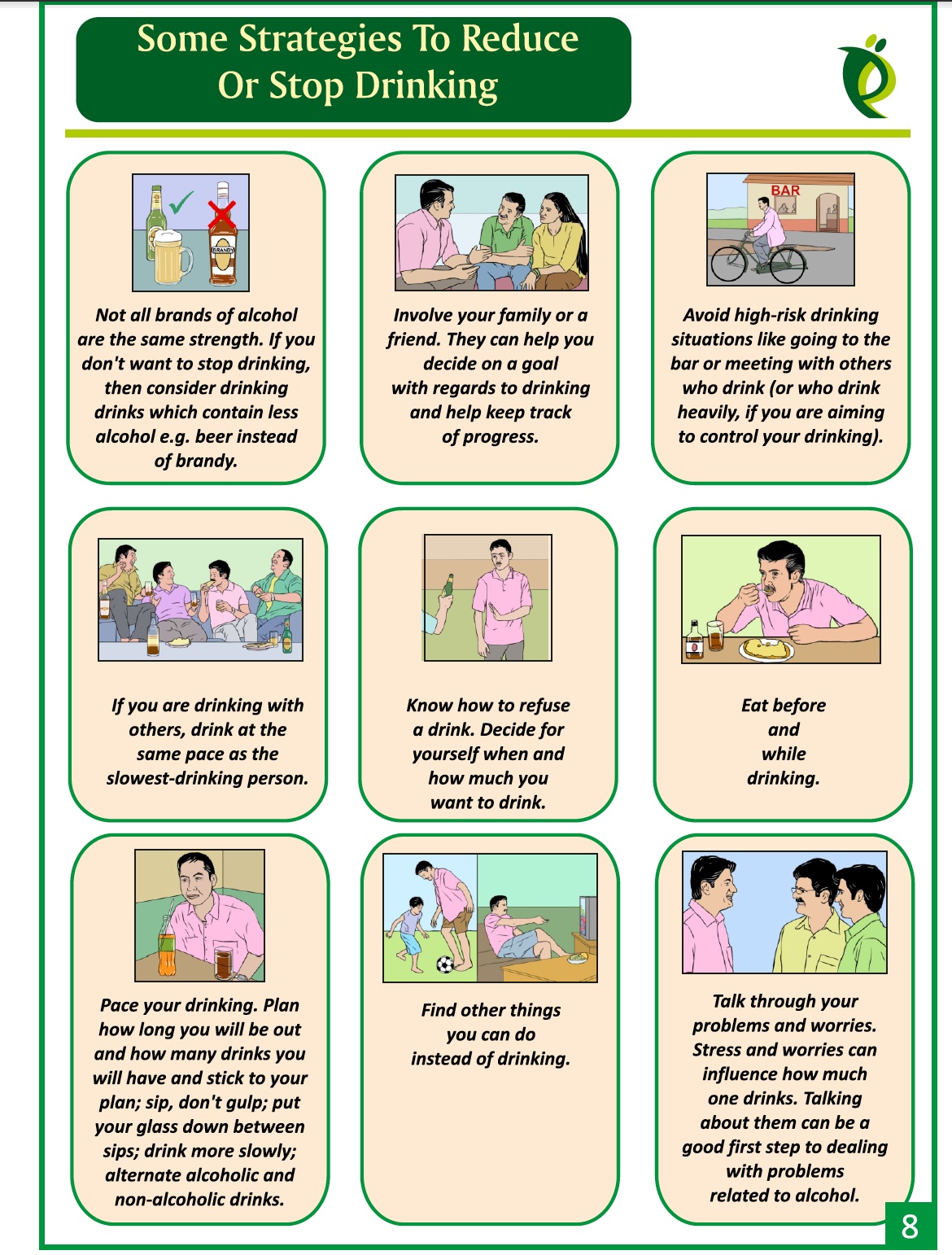
If the patient is trying to stop drinking, he/she can
- Find other enjoyable or interesting things to do
- Avoid high-risk situations such as going to the bar or spending time with those who drink. Avoid going out with friends when he/she gets paid or has a lot of money
- Practice how to refuse a drink
- Involve a family member or friend to support him/her to avoid drinking and track progress
- Talk through problems and concerns. Stress and worries can influence how much one drinks and talking can be the first step to solving problems with alcohol
More material is noted in the patient booklet under Some Strategies To Reduce or Stop Drinking
-
Module 2: Lesson 2: Medication & Treatment of Alcohol Use Disorders
Know the types of medicines patients may be prescribed to treat harmful or dependent drinking. It is important to know what they are for and their effects. More information is available in Appendix 3 of the CAP manual.
Learning objectives
- Which medicines are used in the treatment of alcohol use disorders?
- What is the role of medicines in the treatment of patients with hazardous drinking?
Medicines are mostly prescribed to treat dependent drinkers. You will see some patients with dependent drinking, so it helps to know about the medications they are taking. There are mainly three different types of medicines used to treat dependent drinking
- Medication to treat withdrawal symptoms: Withdrawal is a state that occurs in a dependent drinker after the patient suddenly reduces or stops drinking. Symptoms include restlessness, tremors or hand shaking, rapidly beating heart, sweating, sleep disturbances, and fits (if there is severe dependence). Benzodiazepines are used for a short while, such as one to two weeks, to help get over these symptoms
- Medication to treat alcohol cravings: Some medicines can reduce the strong desire (craving) to drink alcohol to a certain extent.
- Medication used as aversion: These help by making the person dislike alcohol. While they have no effect if alcohol is avoided, they can cause unpleasant symptoms – such as nausea and vomiting or even seizure and raised blood pressure – if alcohol is consumed. Knowing the effects, a patient avoids consuming alcohol when he/she is on this medicine.
-
Module 2: Lesson 3: Counselling for Alcohol Problems (CAP)
The PREMIUM programme developed Counselling for Alcohol Problems (CAP) as a treatment for harmful and dependent drinkers like the ones described in Module 1. It is based on successful methods used in the West and experiences of working with harmful and dependent drinkers in India.
The treatment is brief; mostly limited to two sessions, with a maximum of four sessions. It uses many of the tips outlined earlier to help harmful or dependent drinkers to change. Although this treatment has some written material and homework, it is equally helpful for patients who cannot read as well.
-
Phases of CAP

- CAP has three phases:
- Initial Phase, where we help the patient understand that his/her drinking may be causing problems and the need to change
- Middle Phase, where we help the patient make those changes
- End Phase, where we help the patient plan to deal with possible or actual lapses or relapses and end our treatment.
Often, the Initial Phase is covered in the first session and the Middle and sometimes the End Phases in the second session.
- With some patients, we might move faster and cover all three phases in one session, but this is very rare
- With other patients, it may take a couple of sessions to get through Phase 1, and up to two extra sessions to complete the other phases.
We need to be flexible and change our counselling according to the specific needs of each patient we work with.
-
How the CAP Phases Work

People change their drinking because they:
- Are driven or motivated to change
- Have the confidence to change
- Have decided to change
- Have the skills to behave and think differently
In later modules, we will look at the skills to help people think and behave differently. Change is difficult for many patients so throughout our sessions we have to help them develop and maintain their motivation to change, their confidence that they can do so, and strengthen their decision to make changes. These are the most important tasks we have through all the phases. We can do this by:
- Developing an engaged relationship
- Working together
- Developing and encouraging change talk
- Identifying and discouraging sustained talk
All these terms will be explained later in the course when we go into each phase in detail.
Another element we try to bring in is involving a significant other or SO. The SO is usually a close family member or close friend, who is invited to be involved as long as the patient agrees to it. Involving the SO can help the patient achieve the goals agreed upon, as outlined in the Counselling Relationship manual
-
Module 3: The Style of a CAP Counsellor
Congratulations on completing the Module on the Introduction to Counselling for Alcohol Problems (CAP)! You now know how people stop or reduce drinking, all about the CAP programme and what happens in the four sessions of the CAP programme.
Module 3 highlights the necessary qualities to be an effective CAP counsellor. It includes the CAP programme’s core counselling objectives, and how they help in developing the patient’s session plan and tracking progress.
What you will learn:
- Style of counselling to adopt in CAP
- Counselling objectives
- Essential qualities and skills of a CAP counsellor
-
Module 3: Lesson 1: The four Counselling Objectives
- Developing an engaged relationship with the patient, and their significant other – or SO – if they are present
- Working together with the patient – and their SO if they are present
- Promoting independence by allowing the patient to make decisions rather than making them ourselves, while guiding the patient and the session
- Building and developing the patient’s motivation for change
-
3.1 d - Building and Developing a Patient's Motivation for Change
Table 1: Levels of motivation and areas of focus for counselling
Patient’s level of motivation
Focus of counselling process
Never seriously thought about changing drinking behaviour
Help the patient understand advantages and disadvantages of drinking, and see if we can help him/her make a decision on whether to change things
Has been thinking about making a positive change in drinking behaviour, but still strongly feels like continuing drinking
Help the patient resolve the dilemma and make up his/her mind to change in a positive direction
Already decided to either control or completely stop drinking
Help the patient develop a change plan and work with him/her on putting the change plan into practice, based on a sound understanding of why he/she has decided to change
1 URL -
Module 3: Lesson 2: Three Important Counsellor Skills
A CAP counsellor should know how to: a) identify ‘change talk’, b) cause the patient to engage in ‘change talk’ and c) identify ‘sustain talk’. These skills help build the patient’s motivation to change. Watch the video lecture in the activities section below to learn more.
1 URL -
Module 4: General Format of All CAP Sessions
Congratulations on completing the Module on The Style of a CAP Counsellor! You now know the style of counselling to adopt in CAP, the objectives of the counselling process, and the necessary qualities and skills required to be a CAP counsellor.
The key points you learnt in the previous module must form the basis of every session with all patients, and their significant others – or SOs - if they are present. To review, we must always:
- Develop an engaged relationship with the patient – and the SO if present
- Work together with the patient – and SO if present
- Promote independence by allowing the patient to make decisions themselves, while still guiding the patient and session
- Build and develop the patient’s motivation to change
-
Developing Plans and Target Behaviour
Developing a plan helps both – patient and counsellor – understand what the patient aims to achieve overall (change plan), and the specific tasks he/she aims to achieve between sessions (action plan).
The Change Plan is the overall plan – what the patient wants to achieve with the help of counselling, such as completely stop drinking or learn how to control it. This can be revised and changed, and in each session the counsellor must check if the patient is still happy with the overall plan and aim of the treatment. Generally, however, the change plan does not get changed.
The Action Plan is a list of activities the patient and counsellor agree will be done between sessions. This changes often. For example, one action plan might involve practising drink refusal skills between sessions, while another might involve practising ways to deal with problems at home. Within each action plan, there will be specific homework tasks, such as ‘fill out drinking diary’ or ‘find out information about college course that we have discussed’.
Another idea called Target Behaviour will be discussed later in the course. This is a list counsellors work on during the current session. They involve targets related to drinking (eg not drinking in the coming week, or drinking only on some days, or to a pre-agreed level), and other related activities (eg not seeing friends who pressure the patient to drink, or dealing with an issue at work or home in a way that does not involve drinking).
-
Module 5: Initial Phase - Session One
Congratulations on completing the Module on the General Format of all CAP Sessions! You now know the structure of a CAP session, how to develop plans and target behaviour through change and action plans.
Learning Objectives:
Introducing CAP to the patient
- Set the agenda to help the patient better understand his/her drinking based on the AUDIT assessment
- Offer personalised feedback about drinking
- Help the patient decide goals
- Work with the patient to develop a change plan and action plan
-
Module 5: Lesson 1: Introducing CAP and Setting the Agenda
It is important to set the right tone at the start of the CAP process to reduce the risk of patients dropping out. Watch the video lecture and role play video in the activities section below to learn what to do the first time you meet a patient and how to start him/her off with the therapy process.
2 URLs, 1 File -
Module 5: Lesson 2: Helping the Patient Understand his/her Drinking
The manual outlines a brief description of drinking conditions specified by the AUDIT analysis. Watch the video lecture and role play video in the activities section below to learn how to help the patient understand his/her drinking better.
2 URLs, 1 File -
Module 5: Lesson 3: Providing Personalised Feedback
The initial analysis gives us a better understanding of the patient’s drinking. We can now give the patient (and his/her Significant Other – or SO) feedback about the problem, including how and why their drinking may be harmful and how it may be related to other issues they may have described to us. Personalised feedback is more likely to trigger a stronger commitment in the patient to change.
To offer personalised feedback, we must first explain to the patient (and his/her SO) that we would like to give them feedback which is our understanding of the information that they and their SO have given us. One way you can say this is:
“So, can I sum up here? My colleague asked you some questions when you came to the PHC today, and we have just gone over them again and had a detailed discussion about your drinking and its impact on your life. I would like to share my thoughts about this with (both of) you. This might then help you make decisions about your drinking. Do you think it would be helpful to do that? You can then give me your opinion about what I’m about to say to you”
The information that counsellors offer during personalised feedback includes:
- AUDIT score and what it means. Details are provided in Appendix 4 of the CAP manual
- Level and patterns of his/her drinking
- Various drinking-related problems the patient has reported, and relate that to a summary of the possible negative effects that have been reported in the setting in which the counselling is being provided
- Extra information about the effects of drinking should be given to the patient only if it applies to him/her. For example, if the patient has said that he/she has lost many jobs, you can mention how this is common with people who drink heavily
Patients with an AUDIT score between 12 and 19 are harmful drinkers, and those with an AUDIT score of 20 or more (who also show symptoms of dependency such as withdrawal) are dependent drinkers.
Below is an example of personalised feedback for a harmful drinker:
“I would like to summarise some of the things we discussed today. This will give us the chance to go over what you have told me once again and make any changes or additions. As we discuss this, we could think about working together in the future to develop ways to change your drinking.
You said that your favoured drink is whisky, and you first started drinking eight years ago (although your wife suggested it might have been 10 years ago). You also said you are presently drinking a quarter of whisky four or five days a week. Your AUDIT score is 16, which puts you among people with harmful drinking. This means you drink more heavily than most people, and to a point where it is causing physical and/or mental harm to you. You told me that you continue to drink even though it causes problems at home and at work. Both you and your wife said that your drinking has led to fights and to you getting into trouble with other people.
Your doctor has also now told you that your liver is damaged because of your drinking. So, you, your wife and your doctor have all said that drinking is causing problems with your health, at home and at work.
I think it will be useful for you to know that men who drink as heavily as you do are also more likely to develop psychological problems (such as depression or tension), as well as many more health and other problems of the sort that you already have. They are also more likely to go on to become dependent on alcohol and develop even more serious problems.”
Below is an example of personalised feedback for a dependent drinker:
“I would like to summarise some of the things we discussed today. This will give us the chance to go over what you have told me once again and make any changes or additions. As we discuss this, we could think about working together in the future to develop ways to change your drinking.
You said that your favoured drink is country liquor, and you first started drinking 15 years ago. You also said you are presently drinking a half a bottle of country liquor every day. Your AUDIT score is 23, which puts you among people with dependent drinking. This means that your body has become used to alcohol and you have developed symptoms like vomiting, shaking hands, headaches, etc (this would change depending on the symptoms the patient tells you about). You seem to be drinking much more heavily than most people.
You told me that you continue to drink even though it causes problems at home and at work. Both you and your wife said that your drinking has led to fights and to you getting into trouble with other people.
Your doctor has also now told you that your liver is damaged because of your drinking. So, you, your wife and your doctor have all said that drinking is causing problems with your health, at home and at work. I think it will be useful for you to know that men who drink as heavily as you do are also more likely to develop psychological problems (such as depression or tension), as well as many more health and other problems of the sort that you already have.”
Here, you can show them the patient booklet . Explain and discuss the sections on ‘Types of Drinking Problems’, ‘Impact on Social and Family Life’ and ‘Health Effects’. In the section ‘Understanding Your Drinking’, fill in the amount of alcohol the patient drinks every day, his/her AUDIT score, the box indicating the drinking category he/she falls in, and the amount of money spent on alcohol every month.
You can then ask for overall response to the feedback. Below is an example:
“I have given you quite a bit of information. Have I got everything right do you think?” Followed by: “I wonder what you think of all this”
Sometimes, these statements directly bring about change talk that can be reflected back to the patient. We have already discussed change talk in Module 3.1, and we will say more about it in Module 5.7
Role of the Significant Other in Personalised Feedback:
Involving the Significant Other – or SO – is important as it is more likely to bring about a stronger commitment to change in the patient. If the patient knows that his/her SO has also heard the personalised feedback and understands that he/she has a drinking problem, he/she will not be able to reduce the need to change to the SO.
-
Module 5: Lesson 4: Setting Goals
This section teaches you how to guide the patient in setting goals for himself/herself. Keep in mind the levels of patient motivation you learned in Module 3.
Watch the video lecture in the activities section below to see how to help a patient set goals. Also watch the role play videos to help a patient decide to change and set a goal to stop drinking
3 URLs, 2 Files -
Module 5: Lesson 5: Types of Drinking Goals: Stop or Control Drinking
Patients who want to change their drinking behaviour can either:
- Stop drinking completely, or
- Control their drinking
Below is an example of how to ask a patient what he/she has decided:
“So Mr and Mrs Pereira, we have just gone over all the issues with your drinking and discussed its impact on your health and other areas of your life. As you know, I am here to help you with these problems. But we first need to be clear what you want to do if anything – what is your goal for this treatment? Is it to stop drinking entirely? Or is it to cut down on your drinking and try to make a promise to yourself to control it?”
Although we – as counsellors – may feel that one of these goals is better or more realistic for our patient than the other, we should not make the choice for them. Note that:
- If the patient (and his/her SO if present) choose(s) what to do, they are more likely to achieve it
Often our patient can tell us his/her choice. But sometimes it is useful to discuss with him/her (and his/her SO if present) the advantages and disadvantages of each goal applicable to that patient. Below is an example of how to do so:
“I can see that you are not completely decided on which is the best goal to aim for. Often I find it helpful for us to look at the advantages and disadvantages of each, the good things and the not-so-good things of each. Sometimes, doing this makes it clearer which one you might want to aim for. Are you happy with us trying this?
Let’s look at cutting down on your drinking and trying to control it. What do you think would be the main advantages of doing this?... (Let the patient list out the advantages). What do you think would be the main disadvantages of doing this? … (Let the patient list out the disadvantages). OK, now let’s look at the other choice – stopping drinking altogether. What do you think would be the main advantages of doing this? … (Let the patient list out the advantages). And the what do you think would be the main disadvantages of doing this?... (Let the patient list out the disadvantages)
I have written down the disadvantages and advantages you have told me, and to sum up, you have said that… Has this made things any clearer?”
Up until now, we have discussed these goals as if they are fixed. But it is important that the patient can live ‘one day at a time’. The idea of giving up or controlling alcohol for the rest of his/her life can be stressful for someone with a drinking problem. Instead of making a lifelong commitment or promise to himself/herself, he/she can commit for just the next 24 hours. If he/she continues making this 24-hour commitment every day, it may lead to months and eventually years of staying away from alcohol.
Stopping drinking completely
If the patient chooses this option, it creates an easier situation to handle. This is because most people understand the idea, and you can focus on helping the patient (and his/her SO) to be clear how he/she will go about it, what the obstacles might be and how he/she can overcome them.
Controlling drinking
If the patient settles on this choice, it raises difficulties for a number of reasons.
First, most patients want to ‘cut down on drinking’. While it sounds simple, it often does not work because by the time they are drinking problematically, they will usually have already tried to cut down earlier. The fact that you are seeing them means they have not been successful.
‘Trying to cut down’ is also not clear – by how much will they cut down and to what level? As we explain later, ‘controlled drinking’ is a more exact goal, which will specify in detail how much a patient is aiming to drink and all its details such as when, where and so on.
If patients choose this option, we must find out if they have tried to cut down in the past, and if so, what happened. If they have never tried this in the past, it may be worth getting them to be clear about exactly how much they want to cut down to and how they plan to do so. He/she should be committed about:
- Carefully keeping a record of his/her drinking
- Being absolutely clear about limits of drinking
- Using plans to control drinking, such as taking only a limited amount of money or going to the bar later on
- Carefully planning out the details of the controlled drinking plan
Second, there is also a lot of evidence – though mostly almost entirely from the West – about the types of people or situations where patients find it much more difficult to control their drinking.
-
Module 5: Lesson 6: Helping a Patient Control his/her Drinking
It helps a lot to teach patients new skills and ask them to use these in reaching their goals.
Watch the video lecture and the role play video in the activities section below to learn how to help a patient control his/her drinking.
2 URLs, 1 File -
Module 5: Lesson 7: Developing a Change Plan and Action Plan
Read pages 59-61, which explain the main sections of setting goals – Change Plan and Action Plan. These are included in the patient booklet on pages 15 and 21 respectively. Both help patients achieve their goals through continuous feedback.
-
Module 5: Lesson 8: Ending Session One
Read pages 61 - 64. As important as starting the session well, is ending it well. There is a lot of homework that the patient is asked to do and you need to make sure that it is not too much to handle and that he/she comes back for the next session.
-
Module 6: Middle Phase
Congratulations on completing the Module on the Initial Phase of CAP! You now know how to set an agenda for each session, offer personalised feedback about drinking, help the patient decide goals and how to work with him/her to develop a change and action plan.
-
Module 6: Lesson 1: Reviewing Progress on Action Plan & Change Plan
After the first session, we must review the progress on the Change and Action plans. You will also learn what to do if the patient has not followed the plans. The table below shows the various problems and how to deal with them.
Problem area
Skills
Patient has multiple problems in life
Problem solving skills
Difficulty in saying ‘no’ to friends
Drink refusal skills
Excessive desire for drinking
Skills for management of drinking urge
Stressful life situations and difficulties in handling emotion
Emotions management skills
2 URLs, 1 File -
Module 6: Lesson 2: Targeting Behaviours with Specific Skills
Here, you will learn to show the patient how to change specific behaviours using certain skills for problem solving, drink refusal, handling drinking urges and handling emotions.
In the table in the earlier section, we observed various problems patients faced while attempting the tasks or activities planned in the previous session. The patient sometimes finds it difficult to complete the tasks because:
- He/she is either ambivalent – or unsure – about changing his/her drinking behaviour, in which case we use the motivation-enhancement techniques discussed in Module 3
- Or, he/she lacks the appropriate skills to complete the tasks
For each of the four thinking and behavioural skills that can help in implementing the change plan – problem solving, drink refusal, handling the urge to drink, handling emotions – you will need to check:
- If this is a skill the patient needs for his/her specific situation
- Whether he/she already has the skills or they need to be taught
All the skills can help the patient to either completely stop drinking or control it, but they also help prevent a relapse, which is explained in the End Phase.
Teaching patients these skills will help them develop and use their own ‘coping skills’ [see Glossary - Appendix 1]. Coping skills are skills patients use to deal with (or cope with) challenging situations such as having an urge to drink, feeling a negative emotion, or being pressurised to drink.
Patient's problem areas and skills used to work on them
Problem area
Skills
Patient has multiple problems in life
Problem solving skills
Difficulty in saying ‘no’ to friends
Drink refusal skills
Excessive desire for drinking
Skills for management of drinking urge
Stressful life situations and difficulties in handling emotion
Emotions management skills
-
6.2 c - Handling the Urge to Drink
As patients change their drinking habits, it is normal and common to have urges or cravings for alcohol. Here, you will learn a ‘recognise-avoid-cope’ approach that helps the patient understand how urges work and plan how to handle them.
1 URL -
Module 7: Ending Phase
Congratulations on completing the Module on the Middle Phase of CAP! You now know how to review progress; target behaviours with specific skills; teach the patient how to solve problems independently, refuse drinks, handle an urge to drink and handle emotions.
This module shows you how to teach the patient to avoid a relapse into previous drinking behaviour and deal with a relapse should it occur. You must also end the counselling process by reviewing all the skills and strategies you have shown the patient so far, clarify any skills or doubts he/she may have, and reinforce the patient’s motivation to use all he/she has learnt in other areas of life as well.
-
Module 7: Lesson 1: Relapse Prevention and Managment
A lapse occurs when a patient starts drinking again after a period of planned complete stopping, or when a patient who has been in control of his/her drinking starts drinking a larger amount and/or more frequently than planned during the counselling process. If this happens for a prolonged period, it is a relapse.
A lapse is a single occasion, while a relapse is a series of occasions.
Watch the video lecture in the activities section below to learn how to teach a patient to prevent a relapse and deal with it should it occur.
1 URL -
Module 7: Lesson 2: Preventing a Lapse
There are three key steps to preventing a lapse:
- Identify triggers
- Prevent exposure to triggers
- Cope with triggers differently
You will find detailed information about the different types of triggers in the manual. Patients must learn what triggers their drinking and how to overcome these triggers. While they might feel that further help is not needed following this, it is commonly seen that they go on to relapse. So they must also realise this danger and work out how to use similar skills in a different way, and which new skills they will need to avoid a lapse from turning into a relapse.Patients need to learn how to think through the safe versus risky consequences of all the decisions they make during the day, such as withdrawing extra money from the bank or proving to friends that he/she can resist alcohol by accompanying them to a bar.
-
Module 7: Lesson 3: Preventing a Lapse from Turning into a Relapse
To help our patients commit themselves constantly to attaining their goal of not drinking at all, or controlling their drinking, we need to assure them that lapse and relapse situations are common, but with the correct skills they can withstand these triggers.
You must:
- Help patients prepare, so that if they do lapse they do not allow it to turn into a relapse
- Help patients work through the events that led to a lapse, and how to prevent it from happening again
You can go back to the skills learnt in Phase Two – drink refusal skills, managing emotions, problem solving and handling drinking urges to help them identify the triggers in time to prevent a lapse or relapse.
-
Module 7: Lesson 4: What to do if a lapse turns into a relapse
Patients must always be told that they must return if a lapse turns into a relapse to help them get back on track again. When he/she does return, you can revisit the steps as before and work out with the patient how he/she could do things differently if similar situations arise again.
Significant others, or SOs, can help immensely in preventing and managing relapses. They can help:
- The patient achieve his/her goals
- Identify at-risk situations
- The patient practice skills to avoid and manage the situations
Watch the role play video in the activities section below showing you what to do if the lapse turns into a relapse1 URL, 1 File -
Module 7: Lesson 5: Ending the Treatment
Read pages 100-102 for examples on how to end well.
Remember to go over the End of Treatment form with the patient to discuss the activities he/she has found useful during counselling, go over triggers and high-risk situations, and talk about what can help in difficult situations.
At the end of the counselling process, you must provide the patient with a summary of all the discussions in the previous sessions. It helps to ask the patient and SO to summarise the information, ideas, skills and techniques, and then add any that they have forgotten.
You must try to ask for the patient’s commitment to act on all the decisions he/she has promised to take, and share with him/her and his/her SO your contact number or that of any other service agency for problems related to their drinking in future.
-
Module 8: Challenges to the CAP Process
Congratulations on completing the module on the Ending Phase of CAP! You now know how to teach the patient how to identify triggers and work to prevent lapses and relapses, as well as how to end the treatment process.
There may be certain challenging situations that occur during the counselling process. Watch the video lecture in the activities section below to learn about the various challenges you might face and how to deal with them
1 URL -
Module 9: Depression Plus Drinking Problem
Congratulations on completing the module on the Challenges To The CAP Process! You now understand the various challenging situations that can occur during counselling and how to deal with them.
Some patients might suffer from drinking problems as well as depression. In such patients:
- The two disorders could be unrelated
- Or there could be a relationship
(a) The patient might drink because of his/her depression (to reduce or forget the symptoms of depression); or(b)The depression might be a result of his/heavy drinking (which can cause depression in some people)Watch the video lecture in the activities section below to understand how to find out if a patient with alcohol problems also suffers from depression, and how to treat them
Below is a flow chart showing you the process to follow when treating a patient with drinking problems and depression
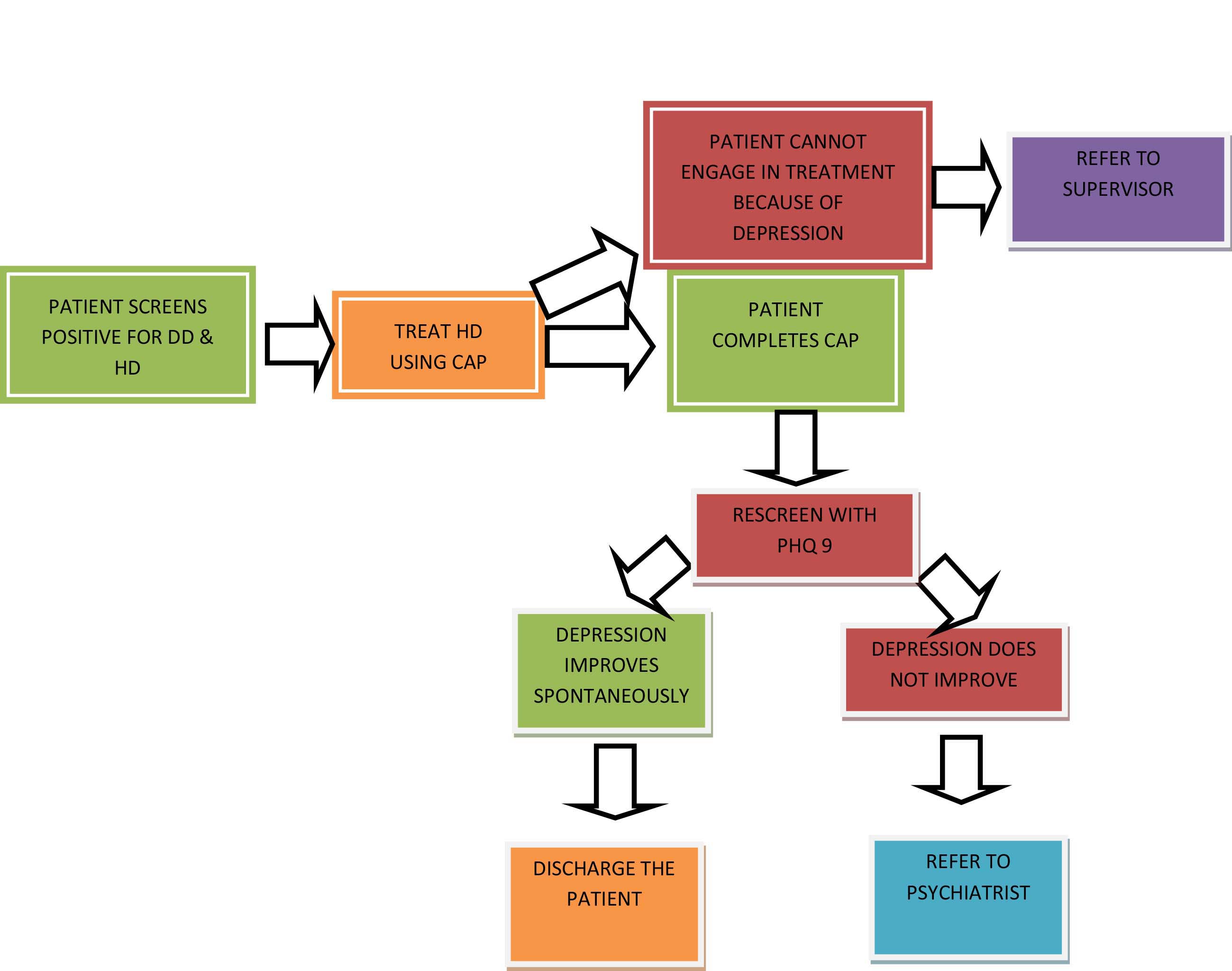 1 URL
1 URL -
Module 10: Tobacco & Alcohol Problems
Congratulations on completing the module on Depression Plus Drinking Problems! You now know how to treat patients who suffer from both depression as well as alcohol use problems.
In this module, you will learn how to help patients who also have a problem with tobacco use.
Tobacco – which is used in forms including chewing, smoking, applying it to the teeth or gums, etc – is highly addictive because it contains nicotine. What is occasional use often turns into a habit, and most believe that it helps them relax, become more alert or fight boredom.
However, tobacco use is hazardous to health, and includes a high risk of early death due to heart disease, breathing difficulties and many types of cancers. Watch the video lecture in the activities section below to understand how to help a patient deal with tobacco problems
1 URL -
Course and Self Evaluation & Certificate
 In this section, you can provide feedback about this course to help us make NextGenU.org better. Once evaluations are completed, you will be able to download your certificate of completion.
In this section, you can provide feedback about this course to help us make NextGenU.org better. Once evaluations are completed, you will be able to download your certificate of completion.



